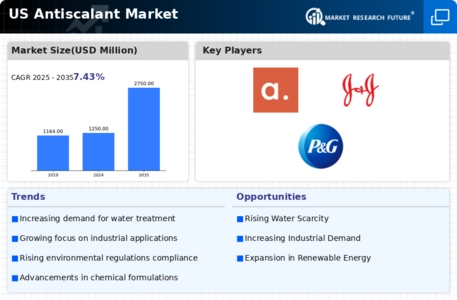Increasing Water Scarcity
The Global US Antiscalant Market Industry is experiencing growth due to rising water scarcity issues. As freshwater resources become increasingly limited, industries are compelled to adopt advanced water treatment solutions, including antiscalants. These chemicals play a crucial role in preventing scale formation in water systems, thereby enhancing efficiency and reducing operational costs. For instance, the market is projected to reach 1250 USD Million in 2024, reflecting a growing awareness of sustainable water management practices. This trend is particularly evident in sectors such as oil and gas, where water reuse is becoming essential for maintaining production levels.
Market Growth Projections
The Global US Antiscalant Market Industry is poised for substantial growth, with projections indicating a rise from 1250 USD Million in 2024 to 2750 USD Million by 2035. This growth trajectory reflects a compound annual growth rate of 7.43% from 2025 to 2035, driven by various factors including increasing water scarcity, technological advancements, and regulatory support. The market's expansion is indicative of the growing recognition of antiscalants as essential components in effective water treatment strategies across multiple industries. As the demand for sustainable water management solutions continues to rise, the antiscalant market is likely to evolve significantly.
Growth in Industrial Applications
The expansion of industrial applications is a key driver for the Global US Antiscalant Market Industry. Industries such as power generation, oil and gas, and manufacturing are increasingly recognizing the importance of antiscalants in maintaining system efficiency and prolonging equipment life. The demand for reliable water treatment solutions in these sectors is expected to surge, contributing to the market's growth trajectory. With the market anticipated to reach 1250 USD Million in 2024, the focus on optimizing water usage and minimizing downtime is becoming paramount. This trend underscores the critical role of antiscalants in industrial water management.
Regulatory Support for Water Quality
Regulatory frameworks aimed at improving water quality are significantly influencing the Global US Antiscalant Market Industry. Governments are implementing stringent regulations that mandate the use of effective water treatment solutions to ensure compliance with environmental standards. This regulatory push encourages industries to invest in antiscalants as a means to prevent scale buildup and maintain water quality. As a result, the market is likely to witness a compound annual growth rate of 7.43% from 2025 to 2035. The alignment of industry practices with regulatory requirements not only promotes sustainability but also enhances operational efficiency.
Rising Awareness of Sustainable Practices
The Global US Antiscalant Market Industry is benefiting from a growing awareness of sustainable practices among industries. Companies are increasingly prioritizing environmentally friendly solutions to address water treatment challenges. Antiscalants, which help in reducing water wastage and improving system efficiency, align well with these sustainability goals. As organizations strive to meet corporate social responsibility objectives, the demand for effective antiscalants is likely to rise. This shift towards sustainability is expected to contribute to the market's growth, with projections indicating a significant increase in market value by 2035.
Technological Advancements in Water Treatment
Technological innovations in water treatment processes are driving the Global US Antiscalant Market Industry forward. New formulations and delivery systems for antiscalants are being developed, which enhance their effectiveness and reduce environmental impact. For example, advancements in polymer chemistry have led to the creation of more efficient antiscalants that require lower dosages, thereby minimizing chemical waste. This trend is expected to contribute to the market's growth, with projections indicating a rise to 2750 USD Million by 2035. The integration of smart technologies in water treatment facilities further supports the adoption of these advanced solutions.














Leave a Comment